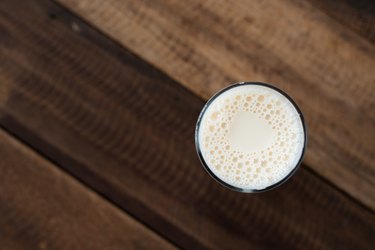
Drinking a glass of milk is part of maintaining a healthy diet — in fact, the USDA recommends that adults consume three 1-cup servings of low-fat or fat-free dairy per day (1 cup of milk is equivalent to one serving). A glass of milk is a good source of calcium, potassium and vitamins D, A and K.
Tip
There are 149 calories in a 1-cup serving of whole milk, according to the USDA’s Food Data Central. The calories in milk for a 1-cup serving of non-fat or skim milk contains 91 calories.
Video of the Day
Glass of Milk Benefits
The USDA recommends consuming three cups of dairy products per day for children and adult men and women (children 2 to 3 years old should have 2 cups per day and children 4 to 8 years old should have 2 1/2 cups). One serving of milk is defined as one cup. The calories in milk will depend on if the glass of milk is whole, reduced fat or skim.
Video of the Day
Milk is rich in calcium — key in building bones and teeth and in maintaining bone mass. Dairy products are the primary source of calcium in American diets, according to the USDA, which notes that consuming the recommended 3 daily cups of dairy products can improve bone mass.
Milk also contains the mineral potassium, necessary to help maintain healthy blood pressure. Other vitamins provided in a glass of milk include vitamin D, which helps the body maintain proper levels of calcium and phosphorous, and vitamins A and K, which play a critical role in maintaining bone health. The USDA advises consuming milk products that are in their low-fat or fat-free forms because they provide little or no solid fat.
Milk Nutrition Data
A 1-cup serving of whole milk contains:
- 149 calories
- 7.9 grams of fat
- 4.6 grams of saturated fat
- 0.5 grams of polyunsaturated fat
- 2 grams of monounsaturated fat
- 24 milligrams of cholesterol
- 105 milligrams of sodium
- 322 milligrams of potassium
- 12 grams of carbohydrates
- 0 grams of dietary fiber
- 12 grams of sugar
- 7.7 grams of protein
- 7.9 percent of the daily value (DV) for vitamin A
- 0 percent DV of vitamin C
- 21 percent DV of calcium
- 0.4 percent DV of iron
In contrast, a 1-cup serving of non-fat or skim milk contains:
- 91 calories
- 0.2 grams of fat
- 0.1 grams of saturated fat
- 0 grams of polyunsaturated fat
- 0.1 grams of monounsaturated at
- 4.9 milligrams of cholesterol
- 103 milligrams of sodium
- 382 milligrams of potassium
- 12 grams of carbohydrates
- 0 grams of dietary fiber
- 12 grams of sugar
- 8.3 grams of protein
- 10 percent of the DV of vitamin A
- 0 percent DV of vitamin C
- 23 percent DV of calcium
- 0.4 percent DV of iron
Downsides to Dairy
Drinking milk and consuming dairy products in moderation, especially when they come from lower or non-fat sources, is recommended as part of a healthy daily diet by the USDA. But there are a few drawbacks to dairy, one of which is for people who experience lactose intolerance — the inability to process dairy. Eating or drinking dairy can cause cramping, bloating, gas and diarrhea with mild to severe symptoms.
Full-fat milk and other dairy products are also high in saturated fats, Harvard University's Nutrition Source points out. This is important to be aware of because a high saturated fat intake is a risk factor for heart disease. Switching to non-fat or skim milk can eliminate the saturated fat in your daily glass of milk.
In general, consuming the daily recommended value of milk and dairy products — especially in a lower fat form — is considered safe and essential to maintaining overall health.
Read more: What Are Some Disadvantages of Dairy Milk?
- USDA Food Data Central: "Milk, Whole"
- USDA National Nutrient Database: "Milk, Nonfat, Fluid, with Added Nonfat Milk Solids, Vitamin A and Vitamin D (Fat Free or Skim)"
- USDA ChooseMyPlate: "All About the Dairy Group"
- Harvard University Nutrition Source: "Calcium: What's Best for Your Bones and Health"